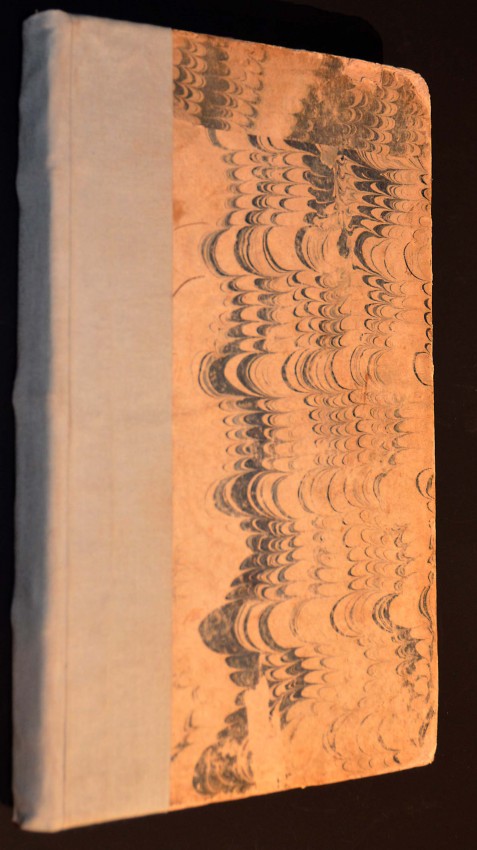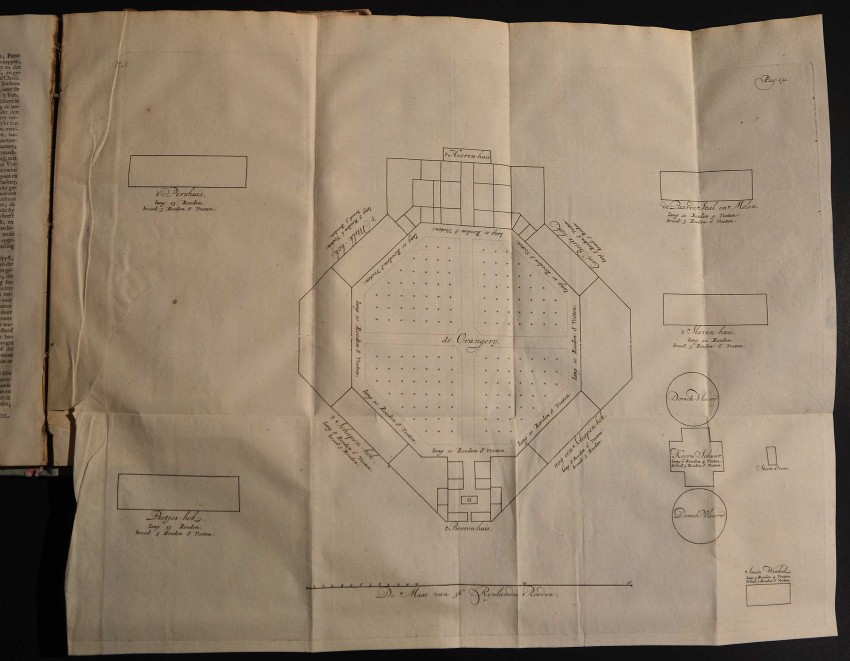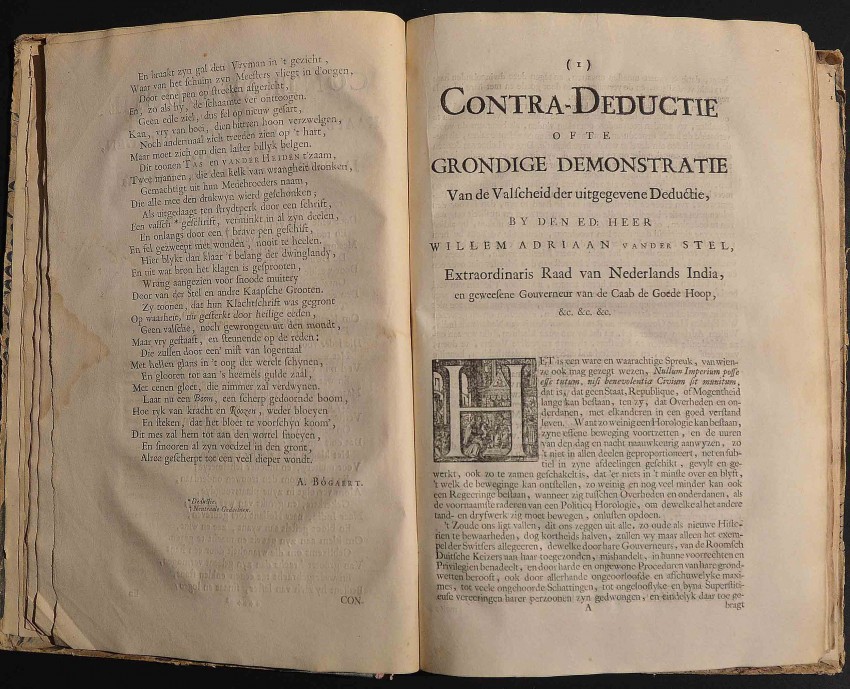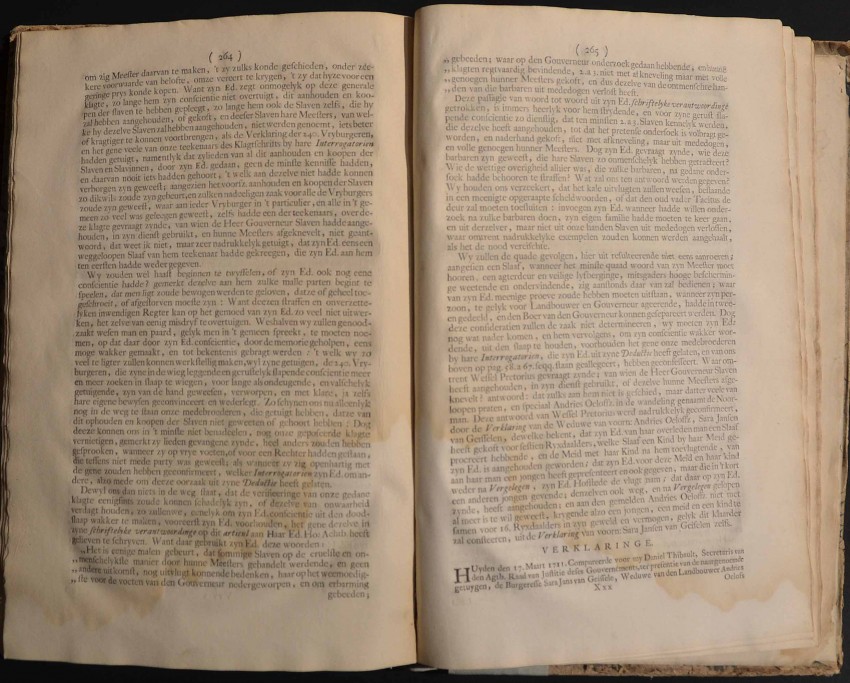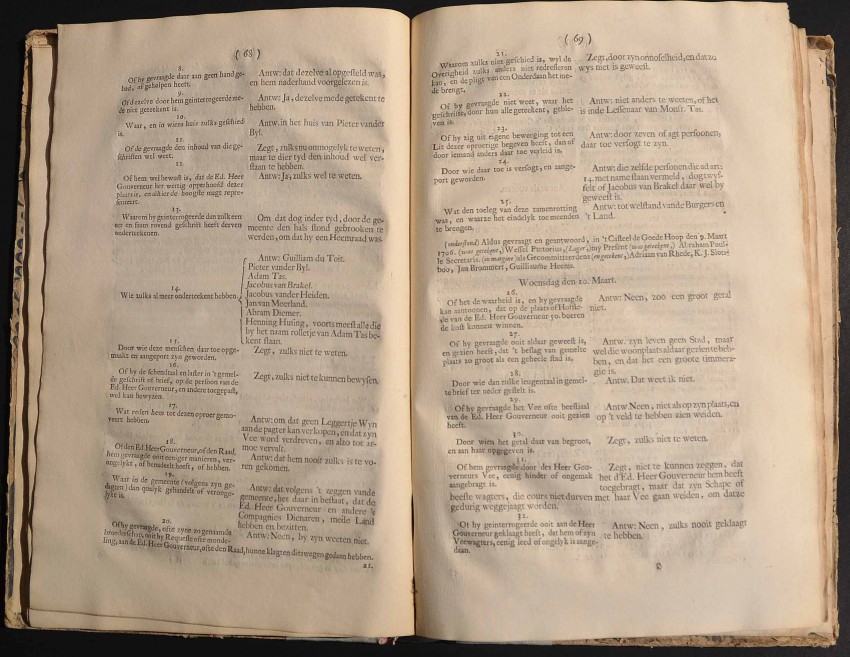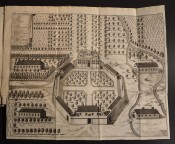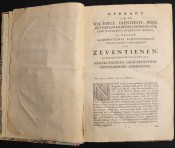The full title occupies the entire title page and abbreviated reads:
Contra-Deductie, ofte Grondige Demonstrasie Van de valsheit der uitgegevene Deductie, By den Ed: Heer Willem Adriaan Van Der Stel …………………De twee Gemachtigden van eenige der Kaapsche Inwonderen Jacobus Vander Heiden en Adam Tas.
304pp. Folio. Publisher: Nicolaas Ten Hoorn, Amsterdam. 1712.
Historical Background and Explanation of this Volume
When Willem Adriaan succeeded his father, Simon van der Stel, as governor of the Cape in 1700, it didn't take long before he claimed a modest 30,000 hectare piece of land for himself just as his father had done in his time at Constantia. It took three days by ox-wagon to reach Willem Adriaan's farm on the slopes of the Hottentots Holland mountain range overlooking the Atlantic Ocean; hence its name 'Vergelegen', meaning 'situated far away'.
Six years after he started planting vines, Willem Adriaan had half a million vine stocks. He laid out fruit orchards and orange groves, planted camphor and oak trees, and established eighteen cattle stations with 1000 cattle and 1800 sheep. Willem Adriaan also built reservoirs and dug irrigation canals. He built himself a beautiful Cape Dutch homestead, added a corn mill and many other subsidiary buildings. Van der Stel was the author of one of South Africa's earliest gardening almanacs. He expanded the VOC's gardens and sent expeditions towards the north to explore the rest of the country. He established the "Land van Waveren", now known as Tulbagh, and laid the cornerstone for the Groote Kerk in Cape Town.
His legacy is however stained by his apparent greed and extravagance. During his rule, van der Stel was viewed as corrupt and dictatorial. He spent much of the VOC resources on the development of Vergelegen, which allowed him an unfair advantage and led to a strained relationship with the local “free burghers”. His unilateral actions determining who could participate in the monopoly of wine and meat triggered a revolt amongst the farmers, and in 1706 Adam Tas, Willem van Zijl and Henning Husing drew up a petition objecting to Van der Stel's activities. Some 63 (out of 550) burghers signed the document and it was sent to the VOC headquarters in Amsterdam. The petition was at first rejected. Van der Stel had Tas arrested, tried and imprisoned—in the "Black Hole" an infamous dungeon at the Castle of Good Hope. Subsequently, the VOC reversed this ruling, dismissed van der Stel, and ordered his return to the Netherlands (April 23, 1707). He left the colony in 1708 and returned to the Netherlands where he spent the rest of his life in exile.
Historians have been divided as to Van der Stel's legacy – hero or villain? Although most sources agree that his rule at the Cape was authoritarian, beset by favouritism, and characterised by misuse of company assets, others claim that this was in no way unique to van der Stel's reign. Early historians such as Theal favoured the former. Later however, others, like Mr. H.C.V. Leibbrandt, Colonial Archivist at the Cape and the historian Ian Colvin, attempted the rehabilitation of the Governor who they claim had been the victim of a complete misconception.The most comprehensive and most recent analysis of "the Van Der Stel issue" has been provided by Leo Fouche in his Appendix to the "Letters of Adam Tas", which he edited and published in 1914 and which makes most interesting reading. The following passages are quotes from this work:
"After van der Stel's recall, there appeared at Amsterdam, anonymously, the well-known 'Korte Deductie,' translated by Leibbrandt under the title of the 'Defence of W.A. van der Stel.' This was indubitably the work of van der Stel himself. It contains the Memorial of the burghers, together with a refutation of the various charges, and a supplement consisting of numerous extracts from official records of every kind, designed to establish the Governor's innocence.
The Counter Defence or 'Contra Deductie.' - The answer of the burghers to van der Stel's Defence was drawn up and published by Tas and van der Heiden, with the authority of their fellows, under the following title: 'The Counter Defence, or Compleat Demonstration of the lying Nature of the Defence published by the Hon. Willem Adriaan van der Stel, etc.' It includes 'an accurate Relation of all the devices contrived by Mr. van der Stel in the year 1706 in order to the subduing of the free burghers at the Cape,' together with 'a concise answer unto all the naked shifts, delusive evidences, and other matters more set forth in the said Defence, as also in the Justification writ in his own hand; designed' (so the title continues) 'unto the substantiating of the Memorial dispatched in the year 1706 unto the Right Honourable and Right Worshipful the Lords Directors in the Illustrious Assembly of Seventeen.'"
This is the volume on offer.
Fouche continues: "As this work is extremely rare and at the same time of supreme importance for the purposes of our investigation, we must here discuss it with some degree of fullness. Compiled in 1711 and published at Amsterdam in the following year, it forms a stout volume of over three hundred folio pages. As the title indicates, it consists of two parts, an historical narrative of the events at the Cape during the struggle between the Governor and the colonists, and an answer to the Governor's Defence, which serves at the same time to substantiate the charges contained in the colonists' Memorial. It comprises a large mass of documentary evidence, including over sixty sworn depositions, drawn by the Secretary to the Council of Policy at the Cape, and subsequently attested under oath before a Committee of the Justiciary Council." Fouche later states that it is relevant that the modern champions of van der Stel attest themselves that they have never had the a volume of the "Korte-Deductie" in their hands. Space precludes further excerpts from this interesting analysis, but I would recommend further reading online at the following link:
http://www.dbnl.org/tekst/tas_003dagb02_01/tas_003dagb02_01_0012.php
Description and Condition.
The volume is rebound in later (but by no means modern) quarter cloth and marbled boards which have moderate edge wear. Between pages 130 and 131 are bound in 3 superb large folding diagrams/charts of the layout of the Vergelegen estate (see images), all in fine condition. The pages of the book have scattered light staining and moderate warping, possibly from exposure to damp. The sewing between pages 300 and 301 has become loose but still just holding. The binding is otherwise firm. Overall in very good condition for a book that is over 300 years old!
Conclusion. This is an important and very scarce item of early Cape history of Museum Piece quality.
- Binding Condition: Good
- Overall Condition: Good
- Size: Folio. 32x20.5cms.
- Sold By: Ronald Levine - Modern First Editions
- Contact Person: Ronald Levine
- Country: South Africa
- Email: [email protected]
- Telephone: 011643 8437
- Preferred Payment Methods: EFT for South African customers and International Bank Tranfer for customers abroad. I am unable to accept payment by credit card.
- Trade Associations: SABDA



